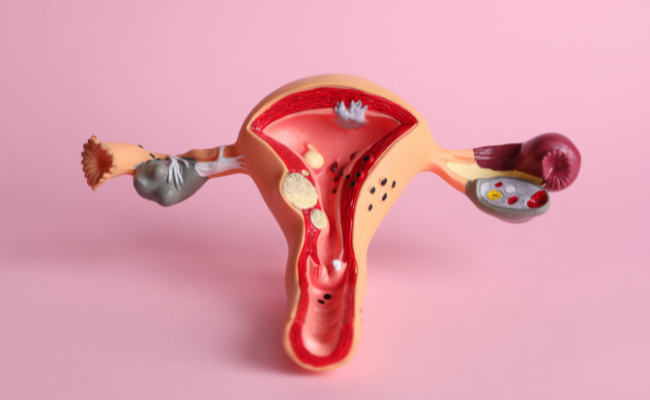How to Treat Fluid In The Pouch Of Douglas?
- September 28, 2023
- 11 Comments

What is Fluid in the Pouch of Douglas?
Fluid in the Pouch of Douglas, also known as the cul-de-sac, is a medical condition characterized by the accumulation of fluid in the space between the rectum and the back wall of the uterus and vagina in women. This condition can be indicative of underlying medical problems and may lead to discomfort or pain.
Why Does Fluid Accumulate in the Pouch of Douglas?
The gathering of fluids in the Pouch of Douglas can be a pathological occurrence, particularly when a woman is lying on her back (supine position). This happens because the rectouterine pouch, located in the lowest part of the peritoneal cavity, is naturally prone to fluid accumulation in this position.
Several factors can contribute to the accumulation of fluid in the Pouch of Douglas, including:
- Infection: Infections in the pelvic area, such as pelvic inflammatory disease (PID) or sexually transmitted infections (STIs), can lead to inflammation and the buildup of fluid in the cul-de-sac.
- Endometriosis: This condition involves the growth of uterine tissue outside the uterus, potentially leading to cyst formation and fluid accumulation in the pelvic cavity.
- Ovarian Cysts: Ruptured ovarian cysts can release fluid into the Pouch of Douglas.
- Menstrual Blood: During menstruation, blood can flow backward through the fallopian tubes and pool in the cul-de-sac, causing fluid buildup.
- Trauma or Surgery: Previous pelvic surgeries or traumatic injuries can sometimes result in adhesions and fluid buildup.
How to Identify Pouch of Douglas Fluid?
- The term "posterior sac," which is another name for the pouch of Douglas, is a space where fluid can accumulate in certain medical conditions.
- To investigate and diagnose potential issues associated with this fluid buildup, a diagnostic procedure known as culdocentesis is performed.
- During culdocentesis, a small sample of fluid is extracted from the pouch of Douglas, also referred to as the posterior cul-de-sac, and tested for any abnormalities.
- Medical evaluation is the key to identifying the presence of fluid in the Pouch of Douglas.
- Typically, transvaginal ultrasound is used for this purpose, allowing for a comprehensive assessment of the affected area.
Treatment Solutions
The treatment of fluid in the Pouch of Douglas depends on the underlying cause and the severity of the condition. Here are common treatment approaches:
- Antibiotics: In cases of infection-related fluid accumulation, antibiotics are prescribed to treat the underlying infection and reduce inflammation.
- Pain Management: Over-the-counter pain relievers or prescription medications are recommended to manage discomfort associated with fluid buildup.
- Hormonal Therapy: For conditions like endometriosis, hormonal therapy can regulate the menstrual cycle and decrease fluid accumulation.
- Surgery: Severe cases, especially those involving cysts, adhesions, or structural issues, may necessitate surgical intervention. Surgical options include fluid drainage, cyst or adhesion removal, or addressing underlying problems.
- Fertility Preservation: If fertility is affected, treatment options can help preserve or restore fertility, enabling individuals to pursue their family planning goals.
Benefits
Treating fluid in the Pouch of Douglas offers several benefits:
- Pain Relief: Treatment alleviates the pain and discomfort associated with fluid accumulation, significantly improving the patient's quality of life.
- Infection Resolution: Antibiotic treatment effectively resolves infections, preventing further complications.
- Chronic Condition Management: For patients dealing with chronic conditions like endometriosis or ovarian cysts, treatment effectively manages underlying issues and prevents future fluid buildup.
- Improved Fertility: Treatment preserves or restores fertility, enabling individuals to pursue their family planning goals.
- Complication Prevention: Timely treatment helps prevent complications such as abscess formation, scarring, and long-term pelvic pain.
- Individualized Care: Treatment plans are personalized to each patient's specific condition and medical history, ensuring they receive the most appropriate care.
- Lifestyle Considerations: Patients may receive guidance on adopting healthier lifestyle changes, including dietary improvements, stress management, and risk avoidance, to support their treatment and overall well-being.
Wonderful Article👌
September, 2023
Super
November, 2023
Thanks for giving information about pouch of douglas 🩷️🩷️
December, 2023
I have learned a lot from this article. Thank you Dr.
December, 2023
Nice Article
February, 2024
nice piece
February, 2024
Thank you for briefing about douglas pouch fluid.
February, 2024
So cute, I love ur teaching
February, 2024
Thank you I have cleared myths and misconceptions.l learnt anlot
February, 2024
This is nice, thanks for the lecture
June, 2024
Thanks DR. For you information now I know some of the underlying causes of free fluid in the Cul de sac.
June, 2024